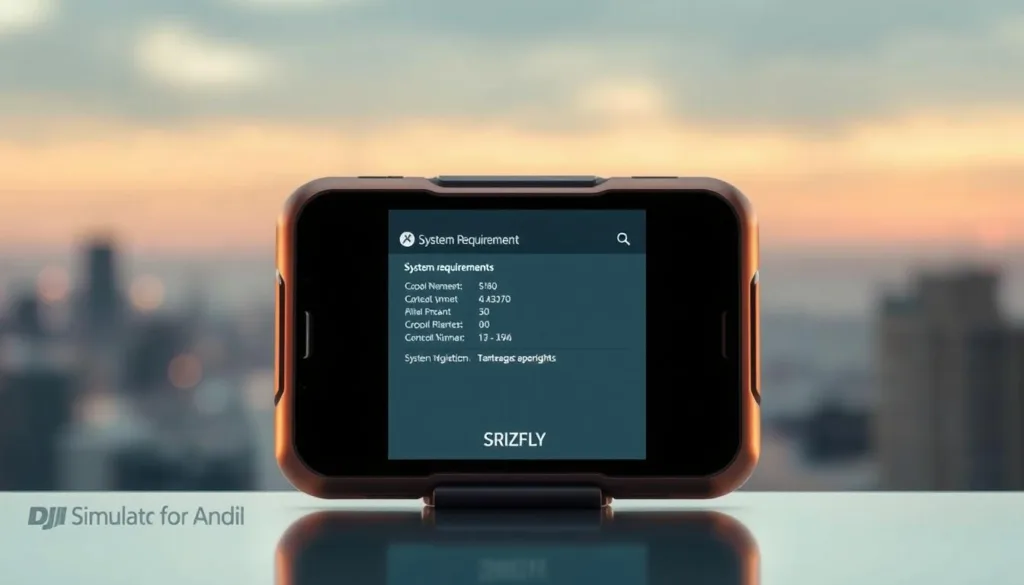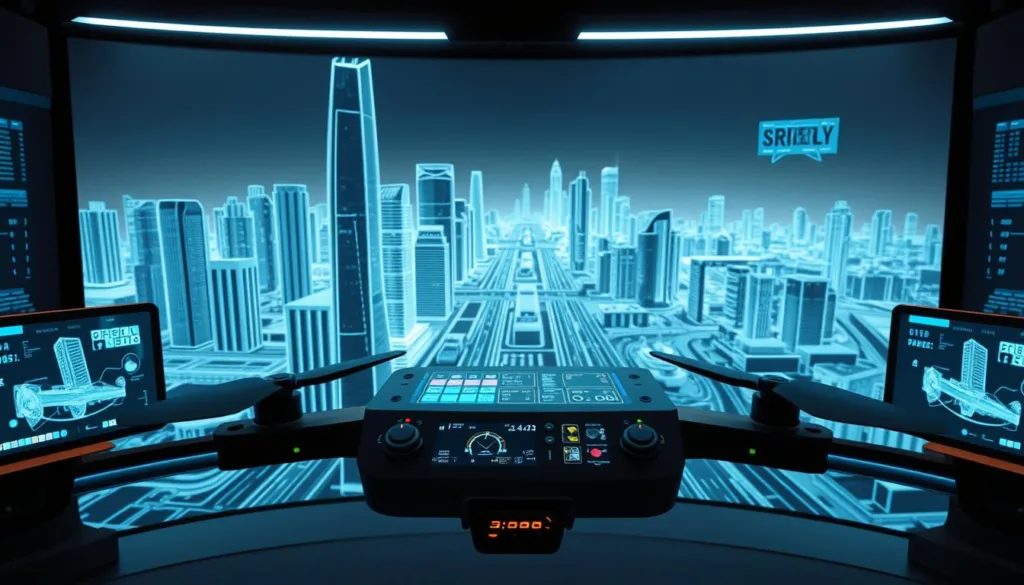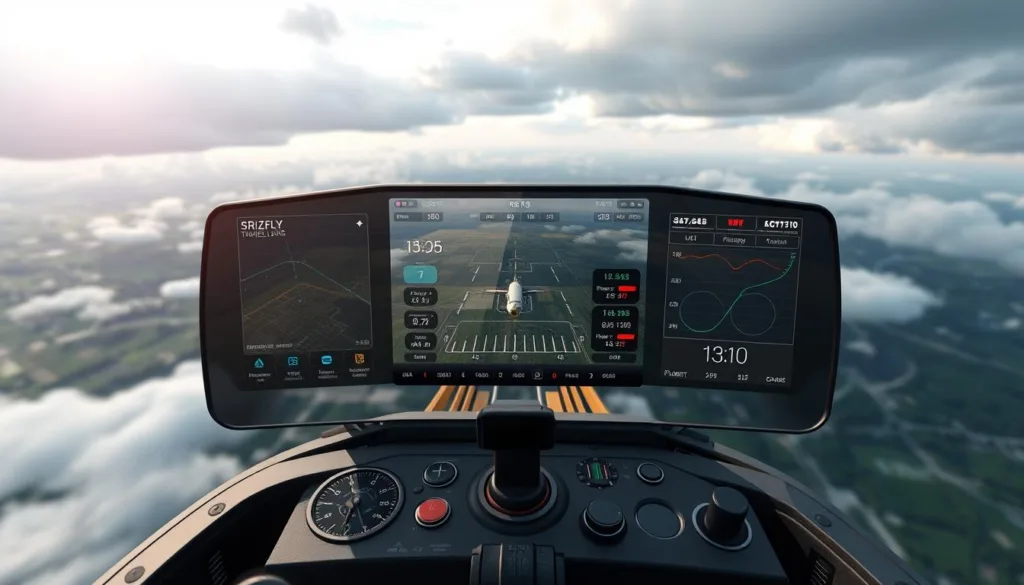Mobile technology now lets aspiring pilots practice aerial maneuvers without leaving the ground. Advanced simulation apps transform smartphones into training hubs, offering lifelike physics and environmental challenges. These tools help users build muscle memory through repeated practice sessions – crucial for mastering complex flight patterns.
Modern platforms replicate real-world scenarios like wind resistance and emergency landings. Many integrate with popular remote controllers, creating seamless transitions between virtual practice and actual flights. This approach reduces repair costs while helping pilots gain confidence in handling unexpected situations.
Key Takeaways
- Mobile apps provide accessible drone training through realistic physics engines
- Virtual environments eliminate risks of damaging equipment during practice
- Weather simulations and obstacle courses enhance situational awareness
- Controller compatibility bridges the gap between simulation and real flights
- Progress tracking helps users identify strengths and improvement areas
Whether preparing for commercial certification or weekend adventures, simulation technology offers valuable practice space. Users can experiment with advanced camera angles and flight modes while receiving instant performance feedback. These features make mobile platforms ideal for both casual flyers and professionals refining their aerial photography techniques.
Introduction to DJI Simulator for Android
The sudden closure of DJI’s official training platform in March 2024 left many professionals scrambling. Flight schools and commercial operators suddenly needed reliable alternatives to maintain certification standards. This shift highlighted the growing importance of virtual practice tools in modern aerial education.
Understanding the Simulator’s Purpose
Modern flight platforms create safe spaces to master tricky maneuvers. Imagine practicing emergency landings or navigating storm simulations without risking expensive gear. These tools help translate textbook knowledge into real-world reflexes through repeated drills.
Detailed performance reports show exactly where skills need polishing. Users can track improvements in response times or camera control over multiple sessions. This instant feedback loop accelerates learning compared to traditional methods.
Why Drone Pilots Are Embracing Virtual Flight
Seasoned operators appreciate practicing during bad weather or equipment downtime. One aviation instructor notes:
“Virtual environments let students make mistakes that would cost thousands in real crashes.”
The app-based approach means practice happens anywhere – during lunch breaks or while traveling. No fuel costs or maintenance fees add up, making skill development more sustainable. As regulations tighten, these training methods help pilots stay sharp between actual flights.
Understanding System Requirements and Optimization
Proper setup begins with matching hardware capabilities to software demands. Flight training apps need robust processing power to render detailed environments and physics calculations. Ensuring your equipment meets baseline specifications prevents frustrating lag or crashes during critical practice moments.

Compatible Device Specifications
Most modern training platforms require Android 10 or newer. Devices with 4GB RAM or higher handle complex simulations better, while 6GB+ ensures multitasking flexibility. Storage space matters too – 2GB free minimum prevents performance bottlenecks during updates.
Graphics processing units (GPUs) determine visual quality. Mid-range chips like Adreno 618 manage basic scenarios, but flagship processors deliver smoother 60fps experiences. Check developer documentation for specific hardware recommendations before downloading.
Optimizing Performance for a Smooth Experience
Close unused apps to free up memory before launching intensive programs. Lower shadow quality or particle effects if animations stutter. One aviation instructor advises: “Treat your phone like flight gear – keep it clean, updated, and charged for peak operation.”
Regular software updates patch compatibility issues while improving stability. Enable developer options to monitor thermal throttling during extended sessions. Using a cooling pad helps maintain consistent frame rates when practicing advanced maneuvers.
Setting Up Your DJI Controller and Device
Connecting your flight gear properly bridges virtual practice and real-world piloting. Modern training apps require precise hardware alignment to mirror actual flight responses. This ensures every stick movement translates accurately to on-screen actions.
Pairing Your Remote Controller
Start by activating pairing mode on your controller – usually done by holding specific buttons. Most apps display clear prompts to sync devices via Bluetooth or USB. Double-check compatibility lists before starting, as some older models need firmware updates.
Motion controllers require extra attention during setup. Enable precise tracking in app settings to capture subtle hand movements. Test responsiveness by practicing basic maneuvers before tackling complex scenarios.
Troubleshooting Connection Issues
If problems arise, restart both devices and verify software versions. A certified instructor notes:
“Ninety percent of connection glitches resolve with updated firmware and proper cable connections.”
Drones controllers sometimes conflict with other Bluetooth devices nearby. Disable unused wireless peripherals during sessions. For persistent latency, try wired connections or specialized adapters recommended by developers.
Remember – the FPV Virtual Flight App doesn’t work with Android, despite some claims. Samsung Galaxy S20 Note tests confirmed this limitation. Always cross-reference official compatibility charts before troubleshooting extensively.
Training Modes and Realistic Flight Experience
Mastering aerial navigation requires adaptable practice spaces that mirror real-world complexity. Modern training platforms offer structured skill-building paths, moving from foundational controls to professional-grade challenges. This layered approach helps users develop confidence through incremental challenges rather than overwhelming trial-and-error sessions.
Exploring Diverse Flight Environments
Virtual landscapes test adaptability across terrains you’ll encounter in actual missions. Urban grids demand precise obstacle avoidance, while mountain ranges teach elevation management. Coastal zones simulate wind patterns that challenge stability, and indoor spaces refine close-quarters control.
Each environment introduces unique weather effects – sudden gusts or rain alter handling characteristics. One flight instructor notes: “Practicing in digital replicas of real locations helps pilots anticipate site-specific risks before deployment.” These scenarios build spatial awareness critical for photography projects or industrial inspections.
Enhancing Your Piloting Skills through Simulation
Emergency drills transform theoretical knowledge into instinctive reactions. Practice power-loss recoveries or sudden system failures without real-world consequences. Precision tasks like threading through hoops or landing on moving targets sharpen coordination.
Manual control modes push abilities further by disabling stabilization assists. “Acro mode demands constant input adjustments,” explains a commercial operator. “Virtual practice builds the muscle memory needed for advanced maneuvers.” Progress tracking shows exactly where to focus improvement efforts.
Mission-based challenges replicate professional workflows – from search patterns to cinematic camera movements. The transition from basic hover exercises to complex operations happens naturally through repeated virtual rehearsals. This methodical skill development creates safer, more capable pilots ready for real-world applications.
How to Use DJI Simulator for Android
Getting started with professional-grade training tools has never been simpler. Modern platforms streamline the learning curve with intuitive interfaces while maintaining realistic flight dynamics. Let’s explore how to maximize these tools for skill development.
Step-by-Step Setup Process
Begin by downloading the virtual flight app from trusted sources like Google Play. Create an account using your professional credentials or personal email. Pair your controller through Bluetooth or USB while following on-screen calibration prompts.
Select your drone model from the supported list – compatibility varies between platforms. Always verify firmware versions before starting practice sessions. Initial setup typically takes 8-12 minutes, depending on connection stability.
Customizing Your Flight Simulation Experience
Adjust graphics settings to balance visual detail with device performance. Choose training environments matching your goals – urban landscapes for obstacle courses or open fields for speed drills. Modify control sensitivity to mirror your actual drone’s response patterns.
Advanced users can program custom weather patterns or mechanical failures. One flight instructor suggests:
“Replicate last year’s windy shoot conditions to practice stabilization techniques.”
Community features let you share custom scenarios or compete on leaderboards.
Platforms like SRIZFLY offer free trials to test premium features risk-free. Regular updates introduce new aircraft models and training modules, keeping practice sessions fresh and challenging. Remember – consistent virtual rehearsals translate to real-world confidence.
Exploring SRIZFLY: The Innovative Alternative
When DJI sunsetted its training platform, professionals needed a reliable solution fast. SRIZFLY stepped up as the officially recognized alternative, combining authentic flight dynamics with cutting-edge skill development tools. This platform bridges the gap between theory and real-world application through precision engineering.

Key Features and Unique Training Benefits
The system replicates aircraft behavior down to camera stabilization patterns. Pilots improve skills through customized weather scenarios and mechanical failure simulations. Detailed analytics highlight reaction times and positioning errors – crucial for mastering complex maneuvers.
Challenge modes with scoring systems turn practice into engaging competitions. One user reported: “The obstacle courses transformed how I approach tight spaces during inspections.” Community features let operators share custom missions, fostering collaborative learning.
DJI Recognition and Compatibility Insights
As the only DJI-approved platform, SRIZFLY guarantees seamless integration with popular aircraft. Supported models range from racing-focused FPV units to cinematic Avata configurations. Controllers pair effortlessly, mirroring real-world response curves and button layouts.
Regular updates ensure compatibility with new releases. A certified trainer notes:
“This forward-thinking approach future-proofs your training investment.”
Whether practicing aerial photography or industrial workflows, the transition from virtual rehearsals to actual flights feels natural.
Conclusion
Virtual training tools have redefined skill development in aerial operations. Platforms like SRIZFLY empower users to master complex maneuvers while eliminating crash risks. This approach saves thousands in equipment repairs while building muscle memory for real-world flying.
Professionals maintain sharp reflexes through customizable scenarios – from storm simulations to equipment failures. Training centers leverage structured lesson plans that mirror certification requirements. Regular updates ensure these tools evolve alongside industry standards.
Accessibility remains key. Support for various devices means pilots can practice advanced techniques during commutes or between jobs. Detailed progress tracking highlights strengths while targeting areas needing improvement.
As virtual environments grow more sophisticated, they bridge the gap between practice and performance. Whether refining camera techniques or emergency protocols, these platforms offer safe spaces to push limits. The future of aerial mastery starts on your screen.
FAQ
Which Android devices work with the virtual flight app?
The app supports smartphones and tablets running Android 6.0 or later with at least 4GB RAM. For optimal performance, use devices with Snapdragon 845 processors or newer. Check the official compatibility list for specific models like Samsung Galaxy S10+ or Google Pixel 5.
Can I practice with DJI’s motion controller in the simulation?
Yes! The training environment replicates real-world flying dynamics, allowing you to connect DJI’s motion controller for FPV and Avata models. This helps refine maneuvers like bank turns and altitude control before actual flights.
How does this tool help improve aerial photography skills?
Virtual scenarios mimic wind resistance, obstacle navigation, and camera adjustments. Pilots can experiment with settings like exposure and gimbal angles in risk-free urban or mountain landscapes, building confidence for complex shoots.
What if my remote won’t pair during setup?
Ensure Bluetooth is enabled and firmware is updated. Restart both devices, disable battery optimization for the app, and reconnect via the controller’s dedicated pairing mode. Persistent issues may require recalibrating joystick inputs.
Are there differences between beginner and advanced training modes?
Beginner mode introduces basic controls with stability assists, while advanced mode removes safety nets and adds challenges like gusty weather. Customizable drills let you focus on weak areas, such as precision hovering or emergency landings.
How does SRIZFLY compare for honing piloting techniques?
SRIZFLY offers unique scenarios like search-and-rescue simulations and supports third-party controllers. While not officially endorsed, it’s recognized for cross-platform flexibility and specialized mission-based exercises beyond standard flight practice.



